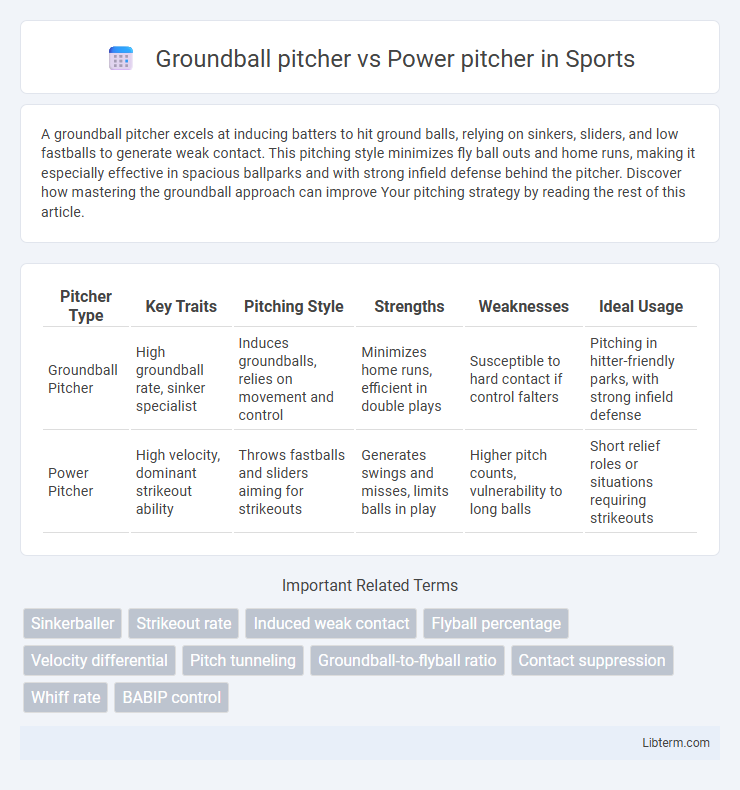A groundball pitcher excels at inducing batters to hit ground balls, relying on sinkers, sliders, and low fastballs to generate weak contact. This pitching style minimizes fly ball outs and home runs, making it especially effective in spacious ballparks and with strong infield defense behind the pitcher. Discover how mastering the groundball approach can improve Your pitching strategy by reading the rest of this article.
Table of Comparison
| Pitcher Type | Key Traits | Pitching Style | Strengths | Weaknesses | Ideal Usage |
|---|---|---|---|---|---|
| Groundball Pitcher | High groundball rate, sinker specialist | Induces groundballs, relies on movement and control | Minimizes home runs, efficient in double plays | Susceptible to hard contact if control falters | Pitching in hitter-friendly parks, with strong infield defense |
| Power Pitcher | High velocity, dominant strikeout ability | Throws fastballs and sliders aiming for strikeouts | Generates swings and misses, limits balls in play | Higher pitch counts, vulnerability to long balls | Short relief roles or situations requiring strikeouts |
Defining Groundball Pitchers and Power Pitchers
Groundball pitchers specialize in inducing hitters to make contact that results in ground balls, relying on pitches with heavy sink and movement to limit airborne hits and promote easy defensive outs. Power pitchers depend on high-velocity fastballs and sharp breaking balls to overpower batters, focusing on strikeouts and weak contact through speed and pitch dominance. Both pitching styles serve distinct strategic roles, with groundball pitchers emphasizing contact management and power pitchers prioritizing raw pitch effectiveness.
Key Differences in Pitching Styles
Groundball pitchers specialize in inducing low, sinking pitches that cause batters to hit balls on the ground, leveraging movement and location to generate weak contact and reduce extra-base hits. Power pitchers rely heavily on high-velocity fastballs and dominant strikeout capabilities, using speed and sheer force to overpower hitters and limit ball contact. The key difference lies in the groundball pitcher's emphasis on control and ball movement versus the power pitcher's focus on velocity and strikeout potential.
Mechanics Behind Groundballs vs. Strikeouts
Groundball pitchers rely on a lower release point and downward plane to induce batters to hit the ball on the ground, emphasizing sinkers and sliders with heavy movement. Power pitchers generate high velocity and sharp vertical or horizontal breaking pitches, maximizing strikeouts through elevated fastballs and sharp breaking balls that exploit swing-and-miss mechanics. The distinct biomechanics influence pitch grip, arm angle, and spin rate, shaping the outcome between groundballs and strikeouts in pitching strategy.
Advantages of Groundball Pitchers
Groundball pitchers excel at inducing ground balls, significantly reducing the risk of extra-base hits and home runs by keeping the ball low in the strike zone. Their ability to generate weak contact leads to efficient outs and minimizes pitch counts, which is advantageous for maintaining stamina throughout the game. Groundball pitchers also benefit from strong infield defense, turning many batted balls into double plays that can quickly end innings.
Advantages of Power Pitchers
Power pitchers excel at generating high-velocity fastballs often exceeding 95 mph, which creates significant difficulty for batters to react and make solid contact. Their ability to rack up strikeouts reduces defensive pressure by limiting balls put into play and potential hits. This dominance through sheer speed and movement enhances their effectiveness in critical game situations, often leading to faster innings and lower pitch counts.
Impact on Team Defense and Fielding
Groundball pitchers generate a high percentage of ground balls, significantly increasing the demand on infielders for quick, precise fielding and double plays. Power pitchers rely on strikeouts and fly balls, reducing ball-in-play opportunities but placing pressure on outfield defenders for difficult catches and limited reaction times. Teams with groundball pitchers often prioritize strong, agile infield defense, while power pitcher teams emphasize outfield range and arm strength to support defensive effectiveness.
Common Pitch Types and Velocity Ranges
Groundball pitchers predominantly rely on sinkers and sliders, typically throwing in the 85-92 mph range to induce weak contact and grounders. Power pitchers favor fastballs and sliders with higher velocity, often reaching 93-100+ mph, aiming to overpower hitters with speed and strikeouts. Both styles utilize curveballs and changeups, but velocity and pitch movement differ significantly to suit their pitching approach.
Performance Trends: ERA, WHIP, and Longevity
Groundball pitchers typically exhibit lower ERAs and WHIPs due to their ability to induce weak contact, leading to fewer extra-base hits and reduced walk rates. Power pitchers often generate higher strikeout rates but may experience elevated ERAs and WHIPs because of increased walk rates and susceptibility to home runs. In terms of longevity, groundball pitchers tend to sustain effectiveness longer, as their pitching style relies less on velocity and more on pitch movement and command.
Tactical Matchups Against Hitters
Groundball pitchers excel at inducing weak contact and double plays, limiting hitters' power and creating opportunities to escape jams with minimal damage. Power pitchers rely on high velocity and strikeout ability to dominate hitters, especially effective against opponents with lower contact rates or those prone to strikeouts. Tactical matchups favor groundball pitchers against aggressive batters who chase fastballs down in the zone, while power pitchers succeed against patient hitters vulnerable to high-velocity strikeout pitches.
Evolving Roles in Modern Baseball
Groundball pitchers dominate with sinkers and induce contact leading to quick outs, reducing home run risks. Power pitchers rely on velocity and strikeouts, overwhelming batters with high spin-rate fastballs and sharp breaking balls. Modern baseball increasingly values hybrid styles blending groundball efficiency with power pitching strikeout potential to adapt to advanced hitter analytics.
Groundball pitcher Infographic

 libterm.com
libterm.com